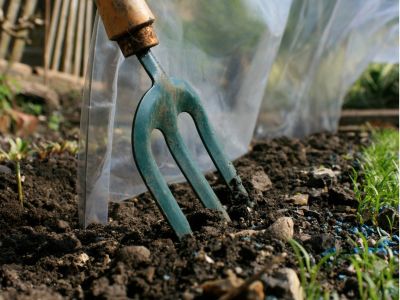Gardeners can create a longer growing season by maintaining a warmer environment around their veggies, particularly when outdoor temperatures are too cold for plant survival. Doing so allows gardeners to plant earlier in the spring and harvest from their garden later in the fall. Here are five inexpensive and easy methods gardeners can use to extend the growing season.
How to Extend the Growing Season
- Plastic Sheeting – Plant earlier in the spring by covering the ground with black plastic mulch. This can increase soil temperature by five degrees (or a change of 2.8 degrees Celsius). Black plastic also helps retain heat longer than bare soil. Or try clear plastic for a temperature increase of 7 to 13 degrees F. (a change of 4-7 degrees C.). However, clear plastic does not deter weed germination and growth. This popular method for extending the growing season works best when the ground is raked smooth, and the sheeting is pulled tight for maximum plastic-to-soil contact.
- Cloches and Hot Caps – From water walls to clear soda bottles with the bottoms cut off, these devices work like a mini-greenhouse to pre-warm the soil and retain higher temperatures around individual plants. These methods create a longer growing season by allowing gardeners to plant as much as three to four weeks earlier in the spring. Proper ventilation is essential when using these devices. Most often, cloches and hot caps will need to be removed to allow for continued plant growth.
- Tunnels – Usually constructed of hoops covered with polyethylene plastic sheeting, both low and high tunnels work to extend the growing season by warming the soil and maintaining a higher ambient temperature around the plants. Also called hoop houses, high tunnels are tall enough for an adult to stand up inside the structure and generally have a more permanent installation than low tunnels. With both types, the interior temperature and humidity require monitoring.
- Floating Row Covers – Often used as a physical barrier to pests, store-bought floating row covers are constructed from spun-bonded or woven polyester or polypropylene fabric and are loosely draped over crops. Row covers retain 5 to 10 degrees F. (or 3-5.5 C.) of warmth and can protect plants from frost damage. Gardeners can also use old sheets or blankets to protect plants from early fall frosts, thus extending the productivity of the garden later into the season.
- Cold Frames – These glass-topped, wooden boxes are often used in the spring to germinate or harden off tender vegetable plants but can also be used during colder months to cultivate cool-season crops like lettuce. A longer growing season can be achieved by turning a cold frame into a hot bed with the installation of waterproof heating cables underneath the soil.
